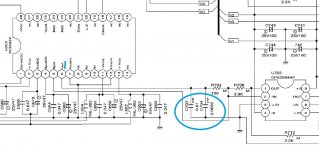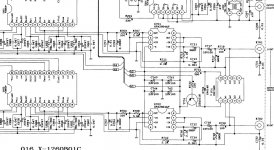Hello,
I own a Rotel RCD-971. I was looking at the schematic which I downloaded from here Rotel RCD-971 - Manual - Stereo Compact Disc Player - HiFi Engine
I see that it has some capacitors from Iout to ground before the op amp.
I've noticed that not many DAC output stages seem to do this.
Is this a good way to design an output filter or not?
What are the disadvantages and advantages?
Any comments welcomed!
Thanks
I own a Rotel RCD-971. I was looking at the schematic which I downloaded from here Rotel RCD-971 - Manual - Stereo Compact Disc Player - HiFi Engine
I see that it has some capacitors from Iout to ground before the op amp.
I've noticed that not many DAC output stages seem to do this.
Is this a good way to design an output filter or not?
What are the disadvantages and advantages?
Any comments welcomed!
Thanks
Attachments
Last edited:
Rotel obviously think it necessary, not only that, they use two in parallel to get a specific value.
Many DAC's use a small cap across the feedback resistor of the opamp, this one does not. Its just a different way of addressing the problem of HF noise from the DAC, either roll it off at source or roll off the response of the following stage... bit over simplified but that would be my take on it.
Many DAC's use a small cap across the feedback resistor of the opamp, this one does not. Its just a different way of addressing the problem of HF noise from the DAC, either roll it off at source or roll off the response of the following stage... bit over simplified but that would be my take on it.
I was really wondering, is that this at first glance looks like a good way of preventing the opamp from receiving too much hf which might upset the opamp. I read some people say that opamps need to have a high bandwidth to sound good as an IV stage to deal with the hf pulses.
So this should ameliorate this problem? ( If we assume it's a problem?), But this cap to ground is not frequently used. Why not?
What's the disadvantage?
So this should ameliorate this problem? ( If we assume it's a problem?), But this cap to ground is not frequently used. Why not?
What's the disadvantage?
You can also have a look at the datasheet of PCM63P here:
PCM63P Datasheet pdf - Colinear 20-Bit Monolithic Audio DIGITAL-TO-ANALOG CONVERTER - Burr Brown
PCM63P Datasheet pdf - Colinear 20-Bit Monolithic Audio DIGITAL-TO-ANALOG CONVERTER - Burr Brown
I've long suspected that the main reason for the apparently big sonic differences that you get when swapping opamps in the output stages of CD players is down to HF affecting the opamp input stages. I read somewhere that the 5532/5534 for example was particularly prone to this, caused in part by its bjt input stage and also input diodes that could partly 'demodulate' the HF and cause non linearities and distortion.
FET opamps are much more immune to this in the first place.
FET opamps are much more immune to this in the first place.
You have to remember that there is virtually no measurable signal voltage at that point because the opamp is configured as an I/V convertor. Even if you placed a 10 ohm across the cap, it wouldn't alter the signal level at the opamp output at lower frequencies, although it would at HF as the opamp ran out of loop gain.
So 18.2nF has no effect at audio frequencies.
Another way of looking at it is that it increases the noise gain of the opamp at HF, which has a similar effect to shunting the feedback resistor with a cap.
So 18.2nF has no effect at audio frequencies.
Another way of looking at it is that it increases the noise gain of the opamp at HF, which has a similar effect to shunting the feedback resistor with a cap.
Op-amp U702 doesn't appear to be connected as an I/V transimpedance amplifier, it instead appears to be connected as an simple inverting voltage amplifier having a gain of (3.9k / 100R = 39). The DAC's current output feeds the 100R op-amp input resistor on one side, and has a virtual ground node on the opposite side. So, the 18.2nF of capacitance from the DAC output to ground is effectively in parallel with the 100R input resistor, and therefore forms a low-pass filter with it. The cut-off frequency looks to be around 87.5kHz.
The output current of the DAC will develop a voltage across the 100R input resistor, which then would be multiplied by the x39 gain of the amplifier.
The output current of the DAC will develop a voltage across the 100R input resistor, which then would be multiplied by the x39 gain of the amplifier.
Last edited:
I felt that the numbers didn't really sound right for the stage to be an inverting amp tbh although the configuration could be either with a value as low as 100 ohm.
One way to tell would be to deliberately increase the 100 ohm. If the DAC was giving a voltage output then the output from the opamp would change as expected. If it was a current output then changes in the 100 ohm (within reason) would not show a change in output voltage at the opamp output, but would instead show a voltage change at the DAC output pin as the current developed a voltage across the resistor. The final output voltage would not change though for the 'current' theory.
One way to tell would be to deliberately increase the 100 ohm. If the DAC was giving a voltage output then the output from the opamp would change as expected. If it was a current output then changes in the 100 ohm (within reason) would not show a change in output voltage at the opamp output, but would instead show a voltage change at the DAC output pin as the current developed a voltage across the resistor. The final output voltage would not change though for the 'current' theory.
- Status
- This old topic is closed. If you want to reopen this topic, contact a moderator using the "Report Post" button.
- Home
- Source & Line
- Digital Source
- Rotel RCD971 PCM63 output filter question

